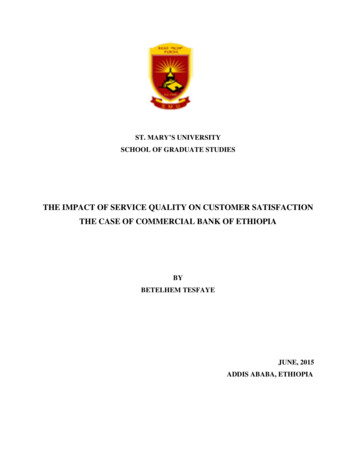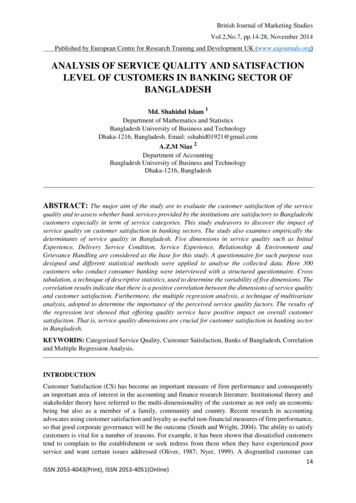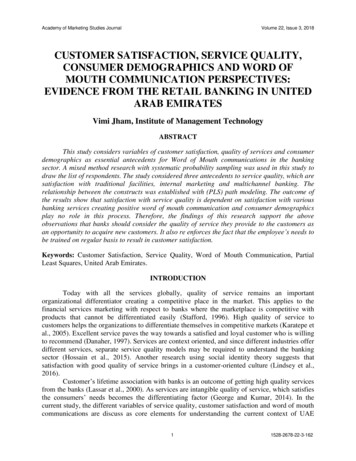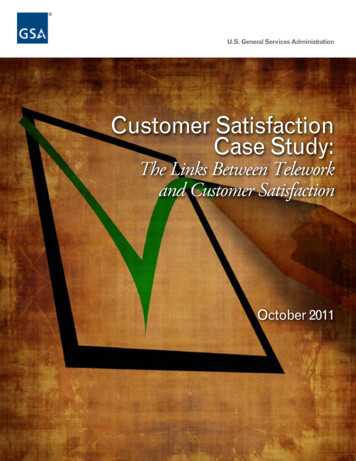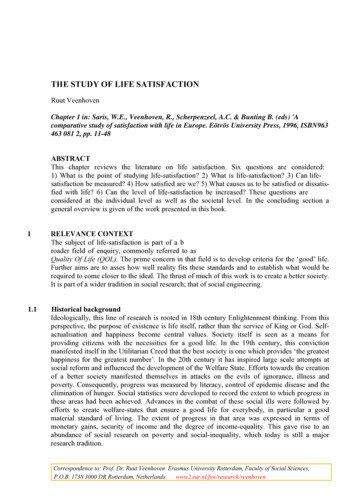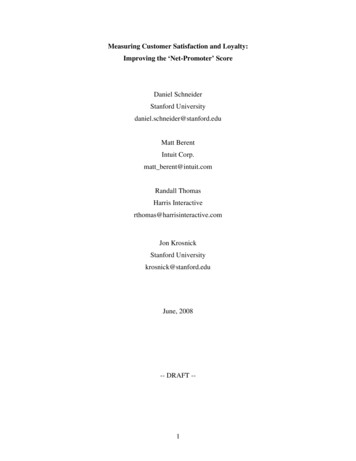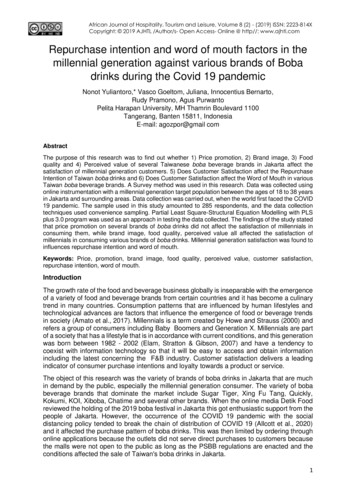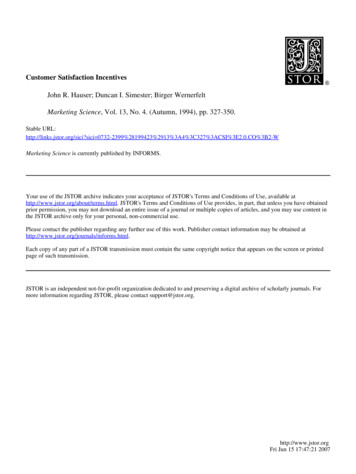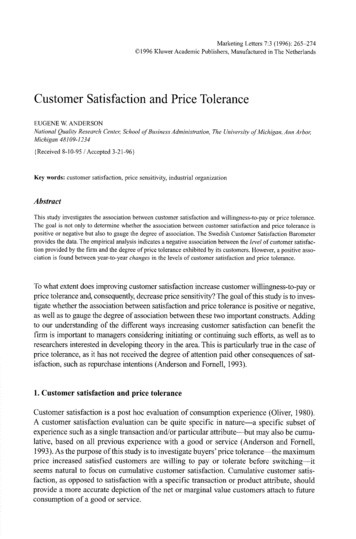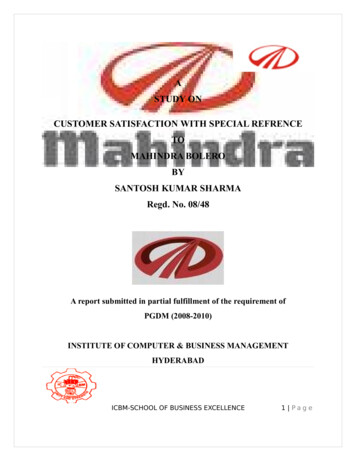
Transcription
ASTUDY ONCUSTOMER SATISFACTION WITH SPECIAL REFRENCETOMAHINDRA BOLEROBYSANTOSH KUMAR SHARMARegd. No. 08/48A report submitted in partial fulfillment of the requirement ofPGDM (2008-2010)INSTITUTE OF COMPUTER & BUSINESS MANAGEMENTHYDERABADICBM-SCHOOL OF BUSINESS EXCELLENCE1 Page
INDEXExecutive Summary (2)Introduction (4)Objective .(8)Research Methodology .(9)Scope and Limitation of Study .(16)Company Profile (17)Product Profile .(29)Dealer Profile .(41)Data Analysis . (50)Finding (61)Recommendation .(63)Conclusion .(65)Bibliography (67)Annexure (70).ICBM-SCHOOL OF BUSINESS EXCELLENCE2 Page
EXECUTIVE SUMMARYMahindra & Mahindra (M&M), the market leader in multi-utility vehicles in India. The companystarted manufacturing commercial vehicles in 1945. M&M is the leader by far in commercialvehicle and the second largest in the passenger vehicle market. The company is the world’s sixthlargest medium and heavy commercial vehicle manufacturing.Mahindra is best known for utility vehicles and tractors in India, Its automotive division, thecompany's oldest unit (founded in 1945), makes jeeps and three-wheelers (not passenger "autorickshaws," but utilitarian delivery and flatbed incarnations). M&M's farm equipment sector,formed in 1963 during India's green revolution, manufactures tractors and industrial engines.M&M also produces military vehicles. The company has facilities located throughout India.The survey involved gathering wide information about the company, its products, customersatisfaction and impact of various competitive firms on the company.From the information collected, various aspects were identified where the company needs tofocus more to improve the efficiency of marketing team of Mahindra Automotives.The research was conducted through collection of primary and secondary data. Secondary datawas collected through visiting various web sites, automobile magazines and other reliablesources. Primary data was collected through a well-framed questionnaire, of which later adetailed analysis was done using various statistical I.T. tools like MS Word and MS Excel.ICBM-SCHOOL OF BUSINESS EXCELLENCE3 Page
On the basis, the secondary data analysis and the extensive analysis of the primary data,interpretations were drawn for the questions and conclusion isdrawn. Certain suggestions arealso drawn from the analysis to help.Mahindra Automotives to increase its market share in commercial passenger segment and MPVs.The main research that followed is to know “Customer satisfaction towards MahindraBOLARO SLX”, a new SUV recently launched by Mahindra. Due to the limited resources andtime constraints, the study was conducted within the area Allahabad city.ICBM-SCHOOL OF BUSINESS EXCELLENCE4 Page
INTRODUCTIONCustomer Satisfaction is the buzzword used by the business people for the success oforganization in the present days. Due to the increases of heavy competition in every product –line it become difficult for the companies to retain the customers for longer time. So retain thecustomer for longer time the marketer has to do only one things i.e. customer satisfaction .Ifcustomer is fully satisfied by the product it not only rub the organization successfully but alsofetch many benefits for the company . They are less process sensitive and they remain customerfor a longer period. They buy addition products overtimes as the company introduce relatedproduce related products or improved, so customer satisfactions is gaining a lot of importance inthe present day. Every company is conducting survey on customer satisfaction level on theirproducts .To make the products up to the satisfaction level of customers.This project is also done to know the customers satisfaction on the BOLERO on behalf ofMahindra and Mahindra Automobiles. The impact of automobile industry on the rest of theeconomy has been so pervasive and momentous that is characterized as second industrial. Itplayed a vital role in helping the nation to produce higher value good and services and in theenhancing their skills and impose tremendous demand for automobile. The decrease in theinterest rate and easy available of cars loons from 2 to 3 years, lot of car manufacturers companyfacing cut throat competition in the fields of technology and price, So to gain the market share itis important for the institutes to satisfy its customers and to retain the reputation and its image.ICBM-SCHOOL OF BUSINESS EXCELLENCE5 Page
Customer Satisfaction Strategies Followed By M&MThe different strategies followed by M&M consists of Customer relationship management,strategy to providing better facility to the owner, and strategy to provide better after sales serviceto customer.Customer Relationship ManagementCRM as a tool was used to create positive word-of-mouth, to monitor customer experiences andgenerate referrals. A series of CRM activities were implemented with regular directcommunication, events and customer satisfaction surveys, Events, Festive offers, RewardsProgram, etc.INTRODUCTION OF AUTOMOBILE INDUSTRYThe automobile industry has changed the way people live and work. The earliest of modern carswas manufactured in the year 1895.Shortly the first appearance of the car followed in India. As the century turned, three cars wereimported in Mumbai (India). Within decade there were total of 1025 cars in the city.The dawn of automobile actually goes back to 4000 years when the first wheel was used fortransportation in India. In the beginning of 15th century,Portuguese arrived in China and theinteraction of the two cultures led to a variety of new technologies, including the creation of awheel that turned under its own power. By 1600s small steam-powered engine models wasdeveloped, but it took another century before a full-sized engine-powered vehicle was created.Brothers Charles and Frank Duryea introduced the actual horseless carriage in the year 1893. Itwas the first internal-combustion motor car of America, and it was followed by Henry Ford’sfirst experimental car that same year.ICBM-SCHOOL OF BUSINESS EXCELLENCE6 Page
One of the highest-rated early luxury automobiles was the 1909 Rolls-Royce Silver Ghost thatfeatured a quiet 6-cylinder engine, leather interior, folding windscreens and hood, and analuminum body.Chauffeurs usually drove it and emphasis was on comfort and style rather than speed.During the 1920s, the cars exhibited design refinements such as balloon tires, pressed-steelwheels, and four-wheel brakes.Graham Paige DC Phaeton of 1929 featured an 8-cylinder engine and an aluminum body.The 1937 Pontiac De Luxe sedan had roomy interior and rear-hinged back door that suited moreto the needs of families. In 1930s, vehicles were less boxy and more streamlined than theirpredecessor was.The 1940s saw features like automatic transmission, sealed-beam headlights, and tubeless tires.The year 1957 brought powerful high-performance cars such as Mercedes-Benz 300SL. It wasbuilt on compact and stylized lines, and was capable of 230 kmph (144 mph).This was the Indian automobile history, and today modern cars are generally light,aerodynamically shaped, and compact.Facts & FiguresThe automobile industry in India is on an investment overdrive. Be it passenger car or twowheeler manufacturers, commercial vehicle makers or three-wheeler companies - everyoneappears to be in a scramble to hike production capacities. The country is expected to witnessover Rs 30,000 crore of investment by 2010.Hyundai will also be unmasking the Verna and a brand new diesel car. General Motors will belaunching a mini and may be a compact car.ICBM-SCHOOL OF BUSINESS EXCELLENCE7 Page
Most of the companies have made their intentions clear. Maruti Udyog has set up the second carplant with a manufacturing capacity of 2.5 lakh units per annum for an investment of Rs 6,500Crore (Rs 3,200 Crore for diesel engines and Rs 2,718 Crore for the car plant itself).Hyundai and Tata Motors have announced plans for investing a similar amount over the next 3years. Hyundai will bring in more than Rs 3,800 Crore to India.Tata Motors will be investing Rs 2,000 Crore in its small car project.General Motors will be investing Rs 100 Crore, Ford about Rs 350 Crore and Toyotaannounced modest expansion plans even as Honda Siel has earmarked Rs 3,000 Crore over thenext decade for India - a sizeable chunk of this should come by 2010 since the company is alsolooking to enter the lucrative small car segment.Talking about the commercial vehicle segment, Ashok Leyland and Tata Motors have eachannounced well over Rs 1,000 Crore of investment. Mahindra & Mahindra's joint venturewith International Trucks is expected to see an infusion of at least Rs 500 Crore.Industry performance in 2008-09The Indian automotive market managed to stand up to the vagaries of the economic meltdown toshow slightly growth during fiscal 2008-09. Overall vehicle sales at 97.23 lakh grew 0.71 percent from 96.54 lakh units in 2007-08.When major automotive markets reported a 30-40 per cent decline, only a handful of countriesmanaged to show growth. A few months ago, India was looking at negative growth but hasturned around. It is actually better than expected.Passenger vehicle sales at 15.51 lakh registered flat growth while commercial vehicle salesshowed a 21 per cent drop.SIAM has a positive outlook for the current financial year. While it foresees a 7-8 per centgrowth for the commercial vehicle segment, the industry body predicts a 3-5 per cent growth forICBM-SCHOOL OF BUSINESS EXCELLENCE8 Page
passenger vehicles. The three-wheeler segment may grow 5-8 per cent growth while twowheelers may show 3-5 per cent growth.The passenger vehicle market has weathered the downturn largely due to market leader MarutiSuzuki which holds 48 per cent of the market. The compact car giant clocked 7.22 lakh unitsfor 2008-09. Closest rival Hyundai Motor India sold 2.44 lakh cars, a growth of 13 per cent.Tata Motors’ sales grew 1.3 per cent at 2.30 lakh units while Mahindra & Mahindra posted 2.5per cent growth at 1.06 lakh units.Most premium carmakers saw volumes shrink last fiscal. Toyota Kirloskar Motor’s numbersfell 15 per cent to 46,892 units while Ford India’s sales were down 17 per cent to 27,976units. Honda Siel Cars India also saw a 17 per cent drop at 52,420 units while GeneralMotors India was down 8 per cent to 61,526 units.Among commercial vehicle makers, all major players saw substantial fall in volumes. Marketleader Tata Motors with a 60 per cent plus share, showed 22 per cent drop in numbers at 2.34lakh units while Ashok Leyland showed 37 per cent drop at 47,632.Eicher’s sales volume fell 37 per cent at 17,341 units and Force Motors was down 28 per centat 7,819 units. “The freight movement is unlikely to improve this fiscal which will impact trucksales.Two-wheeler sales grew 2.6 per cent to 74.38 lakh units. “Hero Honda has made up for theerosion of sales volume for other two-wheeler makers including Bajaj Auto and TVS MotorCompany,” said Mr. Matta. Hero Honda clocked 36.40 lakh units, a growth of 12.5 per cent.Bajaj Auto’s volumes dropped 23 per cent to 12.86 lakh units while TVS saw a marginaldecline at 11.36 lakh units. Honda Motorcycle and Scooter India’s sales surged 16 per cent to10.15 lakh units.OBJECTIVES OF THE STUDYICBM-SCHOOL OF BUSINESS EXCELLENCE9 Page
The study has been under taken to analyze the customer satisfaction towards all variant ofMahindra BOLERO in Allahabad (U.P) with a special reference to the M&M motors, the otherobjectives are: To gather information about customer satisfaction toward Bolero in the geographic regionof Allahabad (UP). To know the customer perception about features, low maintenance cost and looks ofBolero. To know the customer satisfaction about the safety and comfort provided by Bolero. To provide suggestions, in improving the customer satisfaction and the company salesand profitability To know the customer satisfaction towards the after sales service offers by M&M.ICBM-SCHOOL OF BUSINESS EXCELLENCE10 P a g e
RESEARCH METHODOLOGYResearch MethodologyA research process consists of stages or steps that guide the project from its conception throughthe final analysis, recommendations and ultimate actions. The research process provides asystematic, planned approach to the research project and ensures that all aspects of the researchproject are consistent with each other.Research studies evolve through a series of steps, each representing the answer to a key question.INTRODUCTIONThis chapter aims to understand the research methodology establishing a framework ofevaluation and revaluation of primary and secondary research. The techniques and concepts usedduring primary research in order to arrive at findings; which are also dealt with and lead to alogical deduction towards the analysis and results.RESEARCH DESIGNI propose to first conduct a intensive secondary research to understand the full impact andimplication of the industry, to review and critique the industry norms and reports, on whichcertain issues shall be selected, which I feel remain unanswered or liable to change, this shall befurther taken up in the next stage of exploratory research. This stage shall help me to restrict andselect only the important question and issue, which inhabit growth and segmentation in theindustry.ICBM-SCHOOL OF BUSINESS EXCELLENCE11 P a g e
The various tasks that I have undertaken in the research design process are : Defining the information need Design the exploratory, descriptive and causal research.RESEARCH PROCESSThe research process has four distinct yet interrelated steps for research analysisIt has a logical and hierarchical ordering: Determination of information research problem. Development of appropriate research design. Execution of research design. Communication of results.Each step is viewed as a separate process that includes a combination of task , step and specificprocedure. The steps undertake are logical, objective, systematic, reliable, valid, impersonal andongoing.EXPLORATORY RESEARCHThe method I used for exploratory research was Primary Data Secondary dataPRIMARY DATANew data gathered to help solve the problem at hand. As compared to secondary data which ispreviously gathered data. An example is information gathered by a questionnaire. Qualitative orICBM-SCHOOL OF BUSINESS EXCELLENCE12 P a g e
quantitative data that are newly collected in the course of research, Consists of originalinformation that comes from people and includes information gathered from surveys, focusgroups, independent observations and test results. Data gathered by the researcher in the act ofconducting research. This is contrasted to secondary data, which entails the use of data gatheredby someone other than the researcher information that is obtained directly from first-handsources by means of surveys, observation or experimentation.Primary data is basically collectedby getting questionnaire filled by the respondents.SECONDARY DATAInformation that already exists somewhere, having been collected for another purpose. Sourcesinclude census reports, trade publications, and subscription services. There are two types ofsecondary data: internal and external secondary data. Information compiled inside or outside theorganization for some purpose other than the current investigation Researching information,which has already been published? Market information compiled for purposes other than thecurrent research effort; it can be internal data, such as existing sales-tracking information, or itcan be research conducted by someone else, such as a market research company or the U.S.government.Secondary source of data used consists of books and websitesMy proposal is to first conduct a intensive secondary research to understand the full impact andimplication of the industry, to review and critique the industry norms and reports, on whichcertain issues shall be selected, which I feel remain unanswered or liable to change, this shall befurther taken up in the next stage of exploratory research.DESCRIPTIVE RESEARCHSTEPS in the descriptive research:ICBM-SCHOOL OF BUSINESS EXCELLENCE13 P a g e
Statement of the problem Identification of information needed to solve the problem Selection or development of instruments for gathering the information Identification of target population and determination of sampling Plan. Design of procedure for information collection Collection of information Analysis of information Generalizations and/or predictionsDATA COLLECTIONData collection took place with the help of filling of questionnaires. The questionnaire methodhas come to the more widely used and economical means of data collection. The common factorin all varieties of the questionnaire method is this reliance on verbal responses to questions,written or oral. I found it essential to make sure the questionnaire was easy to read andunderstand to all spectrums of people in the sample. It was also important as researcher torespect the samples time and energy hence the questionnaire was designed in such a way, that itsadministration would not exceed 4-5 mins. These questionnaires were personally administered.The first hand information was collected by making the people fill the questionnaires. Theprimary data collected by directly interacting with the people. The respondents were contacted atshopping malls, markets, places that were near to showrooms of the consumer durable productsICBM-SCHOOL OF BUSINESS EXCELLENCE14 P a g e
etc. The data was collected by interacting with 200 respondents who filled the questionnairesand gave me the required necessary information. The respondents consisted of housewives,students, businessmen, professionals etc. the required information was collected by directlyinteracting with these respondents.DETERMINATION THE SAMPLE PLAN AND SAMPLE SIZETARGET POPULATIONIt is a description of the characteristics of that group of people from whom a course is intended.It attempts to describe them as they are rather than as the describer would like them to be. Alsocalled the audience the audience to be served by our project includes key demographicinformation (i.e.; age, sex etc.).The specific population intended as beneficiaries of a program.This will be either all or a subset of potential users, such as adolescents, women, rural residents,or the residents of a particular geographic area. Topic areas: Governance, Accountability andEvaluation, Operations Management and Leadership. A population to be reached through someaction or intervention; may refer to groups with specific demographic or geographiccharacteristics. The group of people you are trying to reach with a particular strategy or activity.The target population is the population I want to make conclude an ideal situation; the samplingframes to matches the target population. A specific resource set that is the object or target ofinvestigation. The audience defined in age, background, ability, and preferences, among otherthings, for which a given course of instruction is intended.I have selected the sample trough Simple random SamplingSAMPLE SIZE:ICBM-SCHOOL OF BUSINESS EXCELLENCE15 P a g e
This involves figuring out how many samples one need.The numbers of samples you need are affected by the following factors: Project goals How you plan to analyze your data How variable your data are or are likely to be How precisely you want to measure change or trend The number of years over which you want to detect a trend How many times a year you will sample each point How much money and manpower you haveSAMPLE SIZEI have targeted 150people in the age group above 21 years for the purpose of the research. Thetarget population influences the sample size. The target population represents the Delhi regions. .The people were from different professional backgrounds.The details of our sample are explained in chapter named primary research where the divisionsare explained in demographics section.ERRORS IN THE STUDYInterviewer errorThere is interviewer bias in the questionnaire method. Open-ended questions can be biased bythe interviewer’s views or probing, as interviewers are guiding the respondent while thequestionnaire is being filled out. The attitudes the interviewer revels to the respondent during theICBM-SCHOOL OF BUSINESS EXCELLENCE16 P a g e
interview can greatly affect their level of interest and willingness to answer openly. Asinterviewers, probing and clarifications maximize respondent understanding and yield completeanswers, these advantages are offset by the problems of prestige seeking, social desirability andcourtesy biases.Questionnaire errorThe questionnaire designing has to careful so that only required data is concisely reveled andthere is no redundant data generated. The questions have to be worded carefully so that thequestions are not loaded and does not lead to a bias in the respondents mindRespondent errorThe respondents selected to be interviewed were not always available and willing to co operatealso in most cases the respondents were found to not have the knowledge, opinion, attitudes orfacts required additionally uninformed response errors and response styles also led to surveyerror.Sampling errorWe have taken the sample size of 150, which cannot determine the buying behavior of the totalpopulation. The sample has been drawn from only National Capital Region.Research DesignResearch design is a conceptual structure within which research was conducted. A researchdesign is the detailed blueprint used to guide a research study towards its objective. It is a seriesof advanced decision taken together comprising a master plan or a model for conducting theICBM-SCHOOL OF BUSINESS EXCELLENCE17 P a g e
research in consonance with the research objectives. Research design is needed because itfacilitates the smooth sailing of the various research operations, thereby making research asefficient as possible yielding maximum information with the minimum effort, time and money.Scope and the Limitation of the study The scope of study is limited to the respondents are selected from in and aroundAllahabad, U.P. The project is carried out for the period of 45 days only. Measurement of customer satisfaction is complex subjects, which uses non-objectivesmethod, which is not reliable. The sample unit was also 150 respondents. However, Mahindra and Mahindra Automobile showrooms are located in other places i.e.locally and even in the neighboring states. Only opinion of respondents of Allahabad citywas consider for finding out the opinions of respondents.ICBM-SCHOOL OF BUSINESS EXCELLENCE18 P a g e
COMPANY PROFILEICBM-SCHOOL OF BUSINESS EXCELLENCE19 P a g e
COMPANY PROFILEHSTORY OF MAHINDRA & MAHINDRA AUTOMOTIVEMahindra & Mahindra (M&M) was established in 1945 as Mahindra & Mohammed. Later on,after the partition of India, one of the partners - Ghulam Mohammad - returned to Pakistan,where he became Finance Minister. As a result, the company was renamed to Mahindra &Mahindra in 1948.M&M started its operation as a manufacturer of general-purpose utility vehicles. It assembledCKD jeeps in 1949. Over the passing years, the company expanded its business and startedmanufacturing light commercial vehicles (LCVs) and agricultural tractors.ICBM-SCHOOL OF BUSINESS EXCELLENCE20 P a g e
Apart from agricultural tractors and LCVs, Mahindra & Mahindra also showed its dexterity inmanufacturing army vehicles. Soon, it started its operations abroad, through its plants set up inChina, the United Kingdom and the USA.M&M partnered with companies prominent in the international market, including Renault SA,International Truck and Engine Corporation, USA, in order to mark its global presence. M&Malso started exporting its products to several countries across the world. Subsequently, it set upits branches including Mahindra Europe Srl (based in Italy), Mahindra USA Inc., MahindraSouth Africa and Mahindra (China) Tractor Co. Ltd.At the same time, M&M managed to be the largest manufacturer of tractors in India, by holdingleadership in the market of the country, for around 25 years. The company is an old hand indesigning, developing, manufacturing and marketing tractors as well as farm implements. Itmade its entry to the passenger car segment in India, with the manufacture of Logan (mid-sizesedan) in April 2007, under the Mahindra Renault collaboration.Soon after the considerable success of Logan, M&M started launching a wide range of LCVsand three wheelers as well as SUVs including Scorpio and Bolero. In the present time, Bolerohas gained immense popularity in India. It is one of the most opted vehicles in its class.MAHINDRA BOLEROMahindra Bolero is one of the most successful and popular utility vehicle of the Mahindra andMahindra Group. The car is robust in appearance and it has been elegantly designed, keeping inmind the conditions of the Indian roads.Mahindra Bolero is also among the best fuel-efficient cars of India as the manufacturer hasequipped it with a 2500 cc diesel engine with5- speed transmission.ICBM-SCHOOL OF BUSINESS EXCELLENCE21 P a g e
MAHINDRA SCORPIOMahindra & Mahindra Limited launched Mahindra Scorpio as its first Sports Utility Vehicle inIndia in 2002.This SUV has redefined the expectations for the design of SUVs with its sturdy looks andpowerful performance, the sophisticated interior design adds to the further glory to theappearance.MAHINDRAINGENIOMahindra & Mahindra is planning to launch a new multi-purpose vehicle (MPV) to take on theToyota Innova and the Chevrolet Tavera in both the individual buyer and taxi segments.Mahindra has currently named the project Ingenio. The vehicle is expected to hit the marketin2009MAHINDRA RENAULT LOGANMuch awaited Mahindra-Renault Logan has been launched in India. This compact sedan is aspacious, practical and affordable vehicle. The outlook of Logan is impressive and the basicversion is a value for money, however the top-end versions are a bit high on price. Theprominent feature of this car is its performance, interiors and economy.MAHINDRA XYLOMahindra & Mahindra Limited launched their latest Multi Utility Vehicle (MUV) “Xylo” inIndia on January 13, 2009. The car boasts of having all the luxurious features that are seen intoday’s sedans, with the ample space of a utility vehicle. Xylo's muscular stance contributes to itscommanding road presence. Fully packed with the latest features, the MUV is sure to impressIndian consumers and provide a stiff competition to the other vehicles within its class.ICBM-SCHOOL OF BUSINESS EXCELLENCE22 P a g e
Performance Of Mahindra XYLOUnder the hood of Mahindra Xylo lies a 4-cylinder turbocharged, mEagle diesel engine, whichgenerates a power of 112bhp @ 3800 rpm and a peak torque of 24 kgm @ 1800-3000 rpm. Thepowerful engine is developed on the NEF CRDe platform and is mated to 5-gears manualtransmission. The car accelerates from rest to 60 km/h in just 5.8 seconds.MILSTONE, AWARDS AND ACCOLADESM&M’s 61st year was studded with a number of noteworthy achievements,prestigious prizes and glittering awards.DUAL HONOURS FOR CHAIRMAN MR. KESHUB MAHINDRAChairman, Mr. Keshub Mahindra was awarded the “Business Visionary Award 2006” institutedby the National Institute of Industrial Engineering (NITIE), Mumbai.Chairman, Mr. Keshub Mahindra was also awarded the prestigious IBS Kolkata LifetimeICBM-SCHOOL OF BUSINESS EXCELLENCE23 P a g e
Achievement Award for his ‘unparalleled contribution to industrial growth and social andeconomic development of the community’.The Institute of Chartered Financial Analysts of India’s (ICFAI) India Business School (IBS)presented it, Kolkata, at the Strategy Summit 2007, held in Kolkata.SLEW OF HONOURS FOR MR. ANAND MAHINDRAMr. Anand Mahindra, VC & MD, Mahindra Group, received a number of prestigious awards in2006-07, including: The prestigious CNBC Asia Business Leader of the Year Award for the Year 2006 as well asthe CNBC TV India “Business Leader of the Year Award”. The ‘CEO of the Year’ award at the India Brand Summit 2006 co-sponsored by BusinessStandard and ITM Business School in association with Times Now and DNA newspaper. The LMA Entrepreneur of the Year 2006 award, instituted by the Ludhiana ManagementAssociation (LMA). The Most Inspiring Corporate Leader of the Year’ Award by NDTV Profit The NDTV Profit – Car & Bike Award 2007 for Automobile Man of the Year.Mr. Anand Mahindra was also nominated as a Member of the Council of the ExecutiveCommittee of the National Sports Development Fund (NSDF) of the Govt. of India. He wasfeatured in the list of 50 Most Influential Indians in Business Week’s edition dated August 13,2007ICBM-SCHOOL OF BUSINESS EXCELLENCE24 P a g e
HIGHEST CRISIL RATING FOR M&MM&M has received the highest Governance & Value Creation rating, CRISIL GVC Level - Ifrom CRISIL for the ability to create value for all stakeholders, while adopting sound corporategovernance practices.DUN & BRADSTREET AMERICAN EXPRESS CORPORATE AWARDS2006Mahindra & Mahindra was rated as the leading Indian company in the Automobile - Tractorssector in the ‘Dun & Bradstreet – American Express Corporate Awards 2006’. The AutomobileSector comprises of three categories – Passenger Vehicles, Commercial Vehicles and Tractors.These awards recognize the virtues of size and growth in the awards methodology. M&M rankedNo. 1 in these two segments in the premier Dun & Bradstreet India publication, India’s Top 500Companies 2006.MAHINDRA RECEIVES AMITY HR EXCELLENCE AWARDMahindra & Mahindra was honored with the Amity HR Excellence Award at the Fourth AmityGlobal HR Summit 2007
CUSTOMER SATISFACTION WITH SPECIAL REFRENCE TO MAHINDRA BOLERO BY SANTOSH KUMAR SHARMA Regd. No. 08/48 A report submitted in partial fulfillment of the requirement of . Honda Siel Cars India also saw a 17 per cent drop at 52,420 units while General Motors India was down 8 per cent to 61,526 units. Among commercial vehicle makers, all major .

